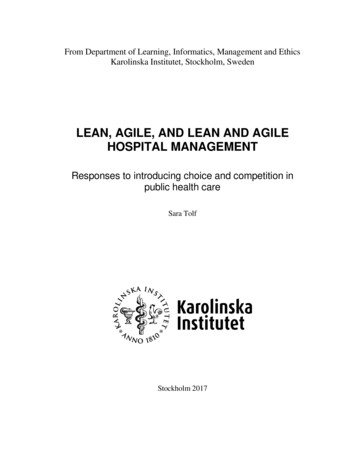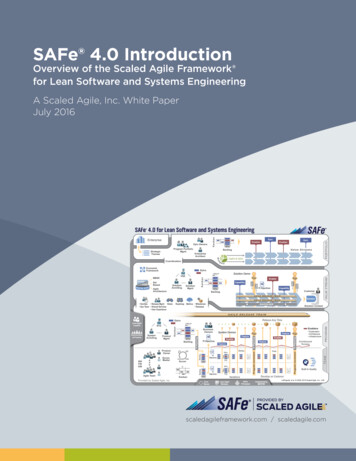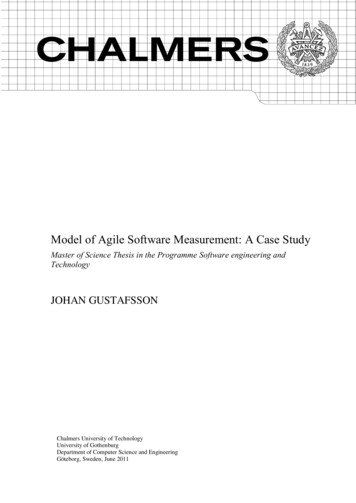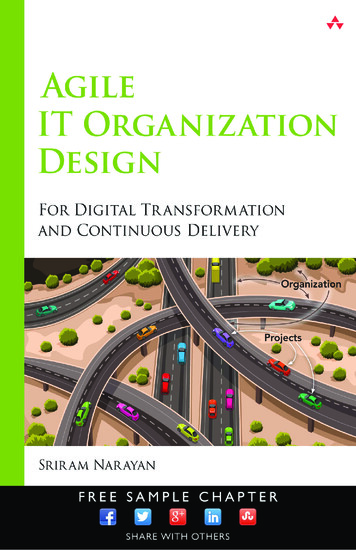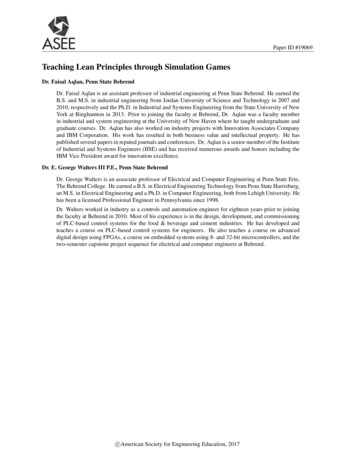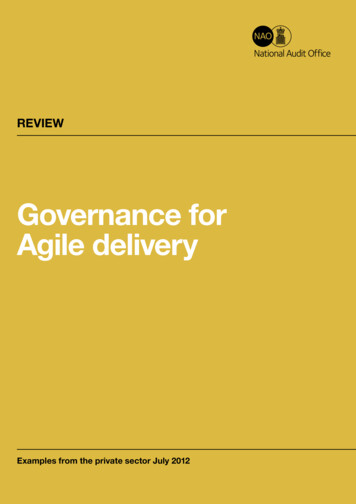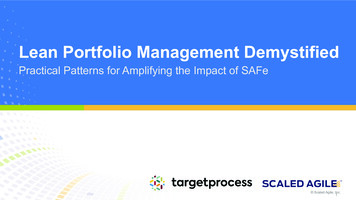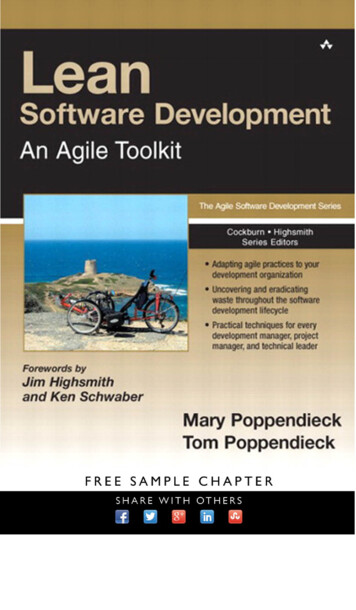
Transcription
Lean SoftwareDevelopment
The Agile SoftwareDevelopment SeriesAlistair Cockburn and Jim Highsmith, Series EditorsVisit informit.com /agileseries for a complete list of available publications.Agile software development centers on four values, which are identified in theAgile Alliance’s Manifesto:1.2.3.4.Individuals and interactions over processes and toolsWorking software over comprehensive documentationCustomer collaboration over contract negotiationResponding to change over following a planThe development of Agile software requires innovation and responsiveness, basedon generating and sharing knowledge within a development team and with thecustomer. Agile software developers draw on the strengths of customers, users,and developers to find just enough process to balance quality and agility.The books in The Agile Software Development Series focus on sharing the experiences of such Agile developers. Individual books address individual techniques (such asUse Cases), group techniques (such as collaborative decision making), and provensolutions to different problems from a variety of organizational cultures. The result is acore of Agile best practices that will enrich your experiences and improve your work.
Lean SoftwareDevelopmentAn Agile ToolkitMary PoppendieckTom PoppendieckBoston San Francisco New York Toronto MontrealLondon Munich Paris MadridCapetown Sydney Tokyo Singapore Mexico City
Many of the designations used by manufacturers and sellers to distinguish their products are claimed as trademarks.Where those designations appear in this book, and Addison-Wesley, Inc. was aware of a trademark claim, the designations have been printed with initial capital letters or in all capitals.The authors and publisher have taken care in the preparation of this book, but they make no expressed or implied warranty of any kind and assume no responsibility for errors or omissions. No liability is assumed for incidental or consequential damages in connection with or arising out of the use of the information or programs contained herein.The publisher offers discounts on this book when ordered in quantity for special sales. For more information, pleasecontact:Pearson Education Corporate Sales DivisionOne Lake StreetUpper Saddle River, NJ 07458(800) 382-3419corpsales@pearsontechgroup.comVisit AW on the Web: www.awl.com/cseng/Library of Congress Cataloging-in-Publication Data availableCopyright 2003 by Addison-WesleyAll rights reserved. No part of this publication may be reproduced, stored in a retrieval system, or transmitted, in anyform, or by any means, electronic, mechanical, photocopying, recording, or otherwise, without the prior consent of thepublisher. Printed in the United States of America. Published simultaneously in Canada.ISBN 0-321-15078-3Text printed in the United States on recycled paper at RR Donnelley in Crawfordsville, Indiana.Seventeenth printing, May 2013
To Dustin, Andy and Brian, Karen and Becca
This page intentionally left blank
ContentsForeword by Jim Highsmith . . . . . . . . . . . . . . . . . . . . . . . . . . . . . . . . . . . . . . . xiiiForeword by Ken Schwaber . . . . . . . . . . . . . . . . . . . . . . . . . . . . . . . . . . . . . . . .xvPreface . . . . . . . . . . . . . . . . . . . . . . . . . . . . . . . . . . . . . . . . . . . . . . . . . . . . . . . .xviiIntroduction . . . . . . . . . . . . . . . . . . . . . . . . . . . . . . . . . . . . . . . . . . . . . . . . . . . xxiChapter 1Eliminate Waste . . . . . . . . . . . . . . . . . . . . . . . . . . . . . . . . . . . . . . .1The Origins of Lean Thinking . . . . . . . . . . . . . . . . . . . . . . . .1Tool 1: Seeing Waste . . . . . . . . . . . . . . . . . . . . . . . . . . . . . .4Partially Done Work . . . . . . . . . . . . . . . . . . . . . . . . . . . . . . . 5Extra Processes . . . . . . . . . . . . . . . . . . . . . . . . . . . . . . . . . . 5Extra Features . . . . . . . . . . . . . . . . . . . . . . . . . . . . . . . . . . . 6Task Switching . . . . . . . . . . . . . . . . . . . . . . . . . . . . . . . . . . 6Waiting . . . . . . . . . . . . . . . . . . . . . . . . . . . . . . . . . . . . . . . . 7Motion . . . . . . . . . . . . . . . . . . . . . . . . . . . . . . . . . . . . . . . . 7Defects . . . . . . . . . . . . . . . . . . . . . . . . . . . . . . . . . . . . . . . . 8Management Activities . . . . . . . . . . . . . . . . . . . . . . . . . . . . 8Tool 2: Value Stream Mapping . . . . . . . . . . . . . . . . . . . . . . .9Map Your Value Stream . . . . . . . . . . . . . . . . . . . . . . . . . . . 9An Agile Value Stream Map . . . . . . . . . . . . . . . . . . . . . . . 11Try This . . . . . . . . . . . . . . . . . . . . . . . . . . . . . . . . . . . . . . .13vii
viiiContentsChapter 2Amplify Learning . . . . . . . . . . . . . . . . . . . . . . . . . . . . . . . . . . . . . 15The Nature of Software Development . . . . . . . . . . . . . . . . 15Perspectives on Quality . . . . . . . . . . . . . . . . . . . . . . . . . . . . 16The Service View of Quality . . . . . . . . . . . . . . . . . . . . . . 16Quality in Software Development . . . . . . . . . . . . . . . . . . 17Variability . . . . . . . . . . . . . . . . . . . . . . . . . . . . . . . . . . . . 17Design Cycles . . . . . . . . . . . . . . . . . . . . . . . . . . . . . . . . . 18Do It Right the First Time? . . . . . . . . . . . . . . . . . . . . . . . 19Learning Cycles . . . . . . . . . . . . . . . . . . . . . . . . . . . . . . . 20Tool 3: Feedback . . . . . . . . . . . . . . . . . . . . . . . . . . . . . . . . 22Software Development Feedback Loops . . . . . . . . . . . . . . . 24Tool 4: Iterations . . . . . . . . . . . . . . . . . . . . . . . . . . . . . . . . 27Iteration Planning . . . . . . . . . . . . . . . . . . . . . . . . . . . . . . . . 29Team Commitment . . . . . . . . . . . . . . . . . . . . . . . . . . . . . . 30Convergence . . . . . . . . . . . . . . . . . . . . . . . . . . . . . . . . . . . 31Negotiable Scope . . . . . . . . . . . . . . . . . . . . . . . . . . . . . . . . 32Tool 5: Synchronization . . . . . . . . . . . . . . . . . . . . . . . . . . . 34Synch and Stabilize . . . . . . . . . . . . . . . . . . . . . . . . . . . . . . . 35Spanning Application . . . . . . . . . . . . . . . . . . . . . . . . . . . . . 36Matrix . . . . . . . . . . . . . . . . . . . . . . . . . . . . . . . . . . . . . . . . 36Tool 6: Set-Based Development . . . . . . . . . . . . . . . . . . . . . 38Set-Based Versus Point-Based . . . . . . . . . . . . . . . . . . . . . . . 38Set-Based Software Development . . . . . . . . . . . . . . . . . . . . 42Develop Multiple Options . . . . . . . . . . . . . . . . . . . . . . . . 42Communicate Constraints . . . . . . . . . . . . . . . . . . . . . . . 43Let the Solution Emerge . . . . . . . . . . . . . . . . . . . . . . . . . 44Try This . . . . . . . . . . . . . . . . . . . . . . . . . . . . . . . . . . . . . . . 45Chapter 3Decide as Late as Possible . . . . . . . . . . . . . . . . . . . . . . . . . . . . . . 47Concurrent Development . . . . . . . . . . . . . . . . . . . . . . . . . 47Concurrent Software Development . . . . . . . . . . . . . . . . . . . 48Cost Escalation . . . . . . . . . . . . . . . . . . . . . . . . . . . . . . . . . . 49
ContentsTool 7: Options Thinking . . . . . . . . . . . . . . . . . . . . . . . . . .52Delaying Decisions . . . . . . . . . . . . . . . . . . . . . . . . . . . . . . 53Options . . . . . . . . . . . . . . . . . . . . . . . . . . . . . . . . . . . . . . . 54Microsoft Strategy, circa 1988 . . . . . . . . . . . . . . . . . . . . . . 55Options Thinking in Software Development . . . . . . . . . . . . 56Tool 8: The Last Responsible Moment . . . . . . . . . . . . . . . . .57Tool 9: Making Decisions . . . . . . . . . . . . . . . . . . . . . . . . . .60Depth-First Versus Breadth-First Problem Solving . . . . . . . . 60Intuitive Decision Making . . . . . . . . . . . . . . . . . . . . . . . . . 61The Marines . . . . . . . . . . . . . . . . . . . . . . . . . . . . . . . . . . . 62Simple Rules . . . . . . . . . . . . . . . . . . . . . . . . . . . . . . . . . . . 64Simple Rules for Software Development . . . . . . . . . . . . . . 65Try This . . . . . . . . . . . . . . . . . . . . . . . . . . . . . . . . . . . . . . .67Chapter 4Deliver as Fast as Possible . . . . . . . . . . . . . . . . . . . . . . . . . . . . . .69Why Deliver Fast? . . . . . . . . . . . . . . . . . . . . . . . . . . . . . . . .70Tool 10: Pull Systems . . . . . . . . . . . . . . . . . . . . . . . . . . . . .71Manufacturing Schedules . . . . . . . . . . . . . . . . . . . . . . . . . 71Software Development Schedules . . . . . . . . . . . . . . . . . . . 74Software Pull Systems . . . . . . . . . . . . . . . . . . . . . . . . . . . . 74Information Radiators . . . . . . . . . . . . . . . . . . . . . . . . . . . . 76Tool 11: Queuing Theory . . . . . . . . . . . . . . . . . . . . . . . . . .77Reducing Cycle Time . . . . . . . . . . . . . . . . . . . . . . . . . . . . . 77Steady Rate of Arrival . . . . . . . . . . . . . . . . . . . . . . . . . . 78Steady Rate of Service . . . . . . . . . . . . . . . . . . . . . . . . . . 79Slack . . . . . . . . . . . . . . . . . . . . . . . . . . . . . . . . . . . . . . . 79How Queues Work . . . . . . . . . . . . . . . . . . . . . . . . . . . . . . 82Tool 12: Cost of Delay . . . . . . . . . . . . . . . . . . . . . . . . . . . .83Product Model . . . . . . . . . . . . . . . . . . . . . . . . . . . . . . . . . 85Application Model . . . . . . . . . . . . . . . . . . . . . . . . . . . . . . . 88Tradeoff Decisions . . . . . . . . . . . . . . . . . . . . . . . . . . . . . . . 91Try This . . . . . . . . . . . . . . . . . . . . . . . . . . . . . . . . . . . . . . .92ix
xContentsChapter 5Empower the Team . . . . . . . . . . . . . . . . . . . . . . . . . . . . . . . . . . . 95Beyond Scientific Management . . . . . . . . . . . . . . . . . . . . . 95CMM . . . . . . . . . . . . . . . . . . . . . . . . . . . . . . . . . . . . . . . . . 97CMMI . . . . . . . . . . . . . . . . . . . . . . . . . . . . . . . . . . . . . . . . . 98Tool 13: Self-Determination . . . . . . . . . . . . . . . . . . . . . . . . 99The NUMMI Mystery . . . . . . . . . . . . . . . . . . . . . . . . . . . . . . 99A Management Improvement Process . . . . . . . . . . . . . . . . 102Tool 14: Motivation . . . . . . . . . . . . . . . . . . . . . . . . . . . . . 103Magic at 3M . . . . . . . . . . . . . . . . . . . . . . . . . . . . . . . . . . . 103Purpose . . . . . . . . . . . . . . . . . . . . . . . . . . . . . . . . . . . . . . 105The Building Blocks of Motivation . . . . . . . . . . . . . . . . . . . 108Belonging . . . . . . . . . . . . . . . . . . . . . . . . . . . . . . . . . . 108Safety . . . . . . . . . . . . . . . . . . . . . . . . . . . . . . . . . . . . . 108Competence . . . . . . . . . . . . . . . . . . . . . . . . . . . . . . . . 109Progress . . . . . . . . . . . . . . . . . . . . . . . . . . . . . . . . . . . . 109Long Days and Late Nights . . . . . . . . . . . . . . . . . . . . . . . . 110Tool 15: Leadership . . . . . . . . . . . . . . . . . . . . . . . . . . . . . 111Leadership . . . . . . . . . . . . . . . . . . . . . . . . . . . . . . . . . . . . 111Respected Leaders . . . . . . . . . . . . . . . . . . . . . . . . . . . . . . 111Master Developers . . . . . . . . . . . . . . . . . . . . . . . . . . . . . . 112The Fuzzy Front End . . . . . . . . . . . . . . . . . . . . . . . . . . . . . 114Where Do Master Developers Come From? . . . . . . . . . . . 115Project Management . . . . . . . . . . . . . . . . . . . . . . . . . . . . 115Tool 16: Expertise . . . . . . . . . . . . . . . . . . . . . . . . . . . . . . 117Nucor . . . . . . . . . . . . . . . . . . . . . . . . . . . . . . . . . . . . . . . . 117Xerox . . . . . . . . . . . . . . . . . . . . . . . . . . . . . . . . . . . . . . . . 118Communities of Expertise . . . . . . . . . . . . . . . . . . . . . . . . . 119Standards . . . . . . . . . . . . . . . . . . . . . . . . . . . . . . . . . . . . . 121Try This . . . . . . . . . . . . . . . . . . . . . . . . . . . . . . . . . . . . . . 122Chapter 6Build Integrity In . . . . . . . . . . . . . . . . . . . . . . . . . . . . . . . . . . . . 125Integrity . . . . . . . . . . . . . . . . . . . . . . . . . . . . . . . . . . . . . . 125
ContentsPerceived Integrity . . . . . . . . . . . . . . . . . . . . . . . . . . . . . . 126Conceptual Integrity . . . . . . . . . . . . . . . . . . . . . . . . . . . . 127The Key to Integrity . . . . . . . . . . . . . . . . . . . . . . . . . . . . . 128Tool 17: Perceived Integrity . . . . . . . . . . . . . . . . . . . . . . .129Model-Driven Design . . . . . . . . . . . . . . . . . . . . . . . . . . . . 131Maintaining Perceived Integrity . . . . . . . . . . . . . . . . . . . . 134Tool 18: Conceptual Integrity . . . . . . . . . . . . . . . . . . . . . .135Software Architecture Basics . . . . . . . . . . . . . . . . . . . . . . 137Emerging Integrity . . . . . . . . . . . . . . . . . . . . . . . . . . . . . . 139Tool 19: Refactoring . . . . . . . . . . . . . . . . . . . . . . . . . . . . .140Keeping Architecture Healthy . . . . . . . . . . . . . . . . . . . . . 141Maintaining Conceptual Integrity . . . . . . . . . . . . . . . . . . 142Isn’t Refactoring Rework? . . . . . . . . . . . . . . . . . . . . . . . . 144Tool 20: Testing . . . . . . . . . . . . . . . . . . . . . . . . . . . . . . . .145Communication . . . . . . . . . . . . . . . . . . . . . . . . . . . . . . . 146Feedback . . . . . . . . . . . . . . . . . . . . . . . . . . . . . . . . . . . . 146Scaffolding . . . . . . . . . . . . . . . . . . . . . . . . . . . . . . . . . . . 147As-Built . . . . . . . . . . . . . . . . . . . . . . . . . . . . . . . . . . . . . . 148Maintenance . . . . . . . . . . . . . . . . . . . . . . . . . . . . . . . . . . 149Try This . . . . . . . . . . . . . . . . . . . . . . . . . . . . . . . . . . . . . .149Chapter 7See the Whole . . . . . . . . . . . . . . . . . . . . . . . . . . . . . . . . . . . . . . .153Systems Thinking . . . . . . . . . . . . . . . . . . . . . . . . . . . . . . .153Tool 21: Measurements . . . . . . . . . . . . . . . . . . . . . . . . . .155Local Optimization . . . . . . . . . . . . . . . . . . . . . . . . . . . . . 157Why Do We Suboptimize? . . . . . . . . . . . . . . . . . . . . . . . 157Superstition . . . . . . . . . . . . . . . . . . . . . . . . . . . . . . . . 158Habit . . . . . . . . . . . . . . . . . . . . . . . . . . . . . . . . . . . . . 158Measuring Performance . . . . . . . . . . . . . . . . . . . . . . . . . 159Information Measurements . . . . . . . . . . . . . . . . . . . . . . . 160Tool 22: Contracts . . . . . . . . . . . . . . . . . . . . . . . . . . . . . .161Can There Be Trust Between Firms? . . . . . . . . . . . . . . . . 161xi
xiiContentsBut Software Is Different . . . . . . . . . . . . . . . . . . . . . . . . . 162The Purpose of Contracts . . . . . . . . . . . . . . . . . . . . . . . . . 164Fixed-Price Contracts . . . . . . . . . . . . . . . . . . . . . . . . . . . . 165Time-and-Materials Contracts . . . . . . . . . . . . . . . . . . . . . . 167Multistage Contracts . . . . . . . . . . . . . . . . . . . . . . . . . . . . 169Target-Cost Contracts . . . . . . . . . . . . . . . . . . . . . . . . . . . 171Target-Schedule Contracts . . . . . . . . . . . . . . . . . . . . . . . . 174Shared-Benefit Contracts . . . . . . . . . . . . . . . . . . . . . . . . . 175The Key: Optional Scope . . . . . . . . . . . . . . . . . . . . . . . . . . 176Try This . . . . . . . . . . . . . . . . . . . . . . . . . . . . . . . . . . . . . . 178Chapter 8Instructions and Warranty . . . . . . . . . . . . . . . . . . . . . . . . . . . . 179Caution—Use Only as Directed. . . . . . . . . . . . . . . . . . . . . 179Instructions . . . . . . . . . . . . . . . . . . . . . . . . . . . . . . . . . . . 180Sphere of Influence . . . . . . . . . . . . . . . . . . . . . . . . . . . . . 180Large Company . . . . . . . . . . . . . . . . . . . . . . . . . . . . . . . . 182Small Company . . . . . . . . . . . . . . . . . . . . . . . . . . . . . . . . 183Special Work Environments . . . . . . . . . . . . . . . . . . . . . . . 184Troubleshooting Guide . . . . . . . . . . . . . . . . . . . . . . . . . . 185Warranty . . . . . . . . . . . . . . . . . . . . . . . . . . . . . . . . . . . . 186Bibliography . . . . . . . . . . . . . . . . . . . . . . . . . . . . . . . . . . . . . . . . . . . . . . . . . . 187Index . . . . . . . . . . . . . . . . . . . . . . . . . . . . . . . . . . . . . . . . . . . . . . . . . . . . . . . . . 195
ForewordBY JIM HIGHSMITHIn February 2001, when “Agile” was adopted as the umbrella word for methodologies such as Extreme Programming, Crystal, Adaptive Software Development,Scrum, and others, the industrial heritage of agile buzzed around in the background. Womack, Jones, and Roos’s The Machine That Changed the World, Smithand Reinertsen’s Developing Products in Half the Time, and Womack and Jones’sLean Thinking have resided on my bookshelf for years. The Agility Forum wasfounded by manufacturers in the early 1990s. The extensive literature on agileand lean industrial product development influenced my work on Adaptive Software Development.But in Lean Software Development, Mary and Tom Poppendieck take lean industrial practices to a new level—they tell us how to apply them directly to software development. It is one thing to read about value stream mapping in amanufacturing plant but quite another to see how this idea applies to software development processes. It is one thing to read about Toyota’s set-based decisionmaking and another to apply those ideas to software design. Mary’s manufacturing and industrial product development experience at 3M gives her insight intohow these practices actually work, and her and Tom’s information technologybackgrounds gives them insight into how to apply the practices to software development.Although Agile Software Development has roots that go back more than 10years, as a movement it is only a couple of years old (in early 2003). Tying it tolean and agile industrial product development provides additional credibility tothe principles and practices of Agile Software Development, but more importantly, it provides a wealth of ideas that can strengthen agile practices.xiii
xivForewordFor example, the set-based decision making previously mentioned countersprevalent ideas about making design decisions. Traditional engineering (software and others) stresses analysis and early decision making so downstream activities can proceed. Set-based development stresses keeping multiple designoptions open in order to have as much information as possible, not only about aparticular piece of the design, but also about the integration of all pieces. Setbased development helps optimize the whole rather than the pieces. Simple design and refactoring serve similar purposes for software developers—pushing offcertain design decisions into the future when more information is available. Setbased development therefore provides a parallel that adds credibility to agilepractices but also shows how to extend those practices.Lean Software Development provides a wealth of information about applyinglean techniques from an industrial setting to software development. In particular, it presents a toolkit for project managers, team leaders, and technologymanagers who want to add value rather than become roadblocks to their projectteams.Jim HighsmithFlagstaff, ArizonaMarch 2002
ForewordBY KEN SCHWABERAgile processes for software development came into being during the 1990’s. Weconstructed them based on experience, trial-and-error, knowledge of what didn’twork, and best practices. I had used Scrum and Extreme Programming-likepractices in my own software company during the early 90’s. When I first formulated the detailed practices of Scrum, I made sure that I tried them on everysort of development situation imaginable before I published my first book aboutScrum. In the absence of first-principles or a theoretical framework for Scrumand other agile processes, I wanted to make sure it really worked before I unleashed more snake oil on the world.Others and I have made attempts to provide a theoretical underpinning toagile processes. I’ve referred back to my research in industrial process controltheory, which friends of mine at DuPont’s Advanced Research Facility helpedme understand and apply. Jim Highsmith has referred to the principles of complex adaptive systems and complexity theory to explain, by analogy, the reasonswhy agile processes work.Mary and Tom Poppendieck have provided us with a more understandable,robust, and everyday framework for understanding the workings of agile processes. I was with them at the XP2002 conference in Sardinia, Italy when Enrico Zaninotto, Dean of Faculty of Economics at the University of Trento, Italygave his keynote talk, “From X Programming to the X Organization.” In thistalk, Enrico laid out the migration of manufacturing from the simple workshopthrough the assembly line to the modern use of lean manufacturing. He clearlydemonstrated the economic imperatives underlying the current use of leanmanufacturing. After the talk, Mary was obviously pleased at this validation. Enrico’s talk brought together her background in manufacturing and product de-xv
xviForewordvelopment with all of the collaborative work she had done with the leanconstruction movement and her knowledge of the Toyota production system.This book is the consequence of the Poppendiecks’ work to pull all of thesemovements and knowledge together. In doing so, they have provided a commonsense set of tools that underlie agile processes. People using agile processescan refer to the 22 tools that Mary and Tom describe to understand why and howthe most common agile processes work, or to modify them based on a deep understanding of them, or to construct their own agile process. The tools in thisbook provide the framework.I took particular pleasure in listening to Enrico and seeing Mary’s andTom’s thinking gel. Our industry has long been burdened by the accusation thatwe should be able to “do it like manufacturing!” The manufacturing this referredto was the Frederick Taylor, Henry Ford assembly line. The systems development processes we constructed on Taylor’s principles didn’t work, and we didn’tknow why. Enrico laughed—“Modern manufacturing left the Taylor principlesbehind twenty years ago!”No longer do we need to refer to such abstruse theory and science as complex adaptive systems to explain agile systems development. We can refer to the22 tools set forth in this book and look to manufacturing and common sense fortheir rationale. We are finally starting to model software development on something that works for us!Ken SchwaberFebruary 2003
PrefaceI used to be a really good programmer. My code controlled telephone switching systems, high energy physics research, concept vehicles, and the makers and coatersused to manufacture 3M tape. I was equally good at writing Fortran or assembly language, and I could specify and build a minicomputer control system as fast as anyone.After a dozen or so years of programming, I followed one of my systems to a manufacturing plant and took the leap into IT management. I learned about materialscontrol and unit costs and production databases. Then the quality-is-free and just-intime movements hit our plant, and I learned how a few simple ideas and empoweredpeople could change everything.A few years later I landed in new product development, leading commercialization teams for embedded software, imaging systems, and eventually optical systems. Iliked new product development so much that I joined a start-up company and laterstarted my own company to work with product development teams, particularly thosedoing software development.I had been out of the software development industry for a half dozen years, and Iwas appalled at what I found when I returned. Between PMI (Project Management Institute) and CMM (Capability Maturity Model) certification programs, a heavy emphasis on process definition and detailed, front-end planning seemed to dominateeveryone’s perception of best practices. Worse, the justification for these approacheswas the lean manufacturing movement I knew so well.I was keenly aware that the success of lean manufacturing rested on a deep understanding of what creates value, why rapid flow is essential, and how to release thebrainpower of the people doing the work. In the prevailing focus on process and planning I detected a devaluation of these key principles. I heard, for example, that detailed process definitions were needed so that “anyone can program,” while leanxvii
xviiiPrefacemanufacturing focused on building skill in frontline people and having them definetheir own processes.I heard that spending a lot of time and getting the requirements right upfrontwas the way to do things “right the first time.” I found this curious. I knew that theonly way that my code would work the first time I tried to control a machine was tobuild a complete simulation program and test the code to death. I knew that everyproduct that was delivered to our plant came with a complete set of tests, and “rightthe first time” meant passing each test every step of the way. You could be sure thatnext month a new gizmo or tape length would be needed by marketing, so the idea offreezing a product configuration before manufacturing was simply unheard of. That’swhy we had serial numbers—so we could tell what the current manufacturing specwas the day a product was made. We would never expect to be making the exact sameproducts this month that we were making last month.Detailed front-end planning strikes me as diametrically opposed to lean manufacturing principles. Process definition by a staff group strikes me as diametrically opposed to the empowerment that is core to successful lean manufacturing. It seems tome that the manufacturing metaphor has been misapplied to software development.It seems to me that CMM, in its eagerness to standardize process, leaves out the heartof discovery and innovation that was the critical success factor in our move to totalquality management. We knew in manufacturing that ISO9000 and even MalcolmBaldrige awards had little or nothing to do with a successful quality program. Theywere useful in documenting success, but generally got in the way of creating it.It seems to me that a PMI certification program teaches a new project managerseveral antipatterns for software project management. Work breakdown. Scope control. Change control. Earned value. Requirements tracking. Time tracking. I learnedall about these when I was a program manager for government contracts at 3M, andwas keenly aware of the waste they added to a program. We certainly knew better thanto use them on our internal product development programs, where learning and innovation were the essential ingredients of success.This is not to say that CMM and PMI are bad, but only that for anyone who haslived through the lean revolution, they tend to give the wrong flavor to a software development program. In this book we hope to change the software development paradigm from process to people, from disaggregation to aggregation, from speculation todata-based decision making, from planning to learning, from traceability to testing,from cost-and-schedule control to delivering business value.If you think that better, cheaper, and faster can’t coexist, you should know thatwe used to think the same way in the pre-lean days of manufacturing and product development. However, we learned that by focusing on value, flow, and people, you got
Acknowledgmentsbetter quality, lower cost, and faster delivery. We learned that from our competitors asthey took away our markets.May you lead your industry in lean software development.Mary PoppendieckACKNOWLEDGMENTSThis book is in our words, but the ideas came from the agile community. Lean principles have had decades of success in lean manufacturing, logistics, and construction.These same principles, which are the framework of this book, are finally emerging asagile software development.Many reviewers invested thoughtful hours reading and providing feedback thathelped us refine our ideas and presentation, including Ken Schwaber, Jim Highsmith,Alistair Cockburn, Luke Hohmann, Martin Fowler, pragmatic Dave Thomas, BillWake, Rob Purser, Mike Cohn, and Martha Lindeman. Thanks to Glenn Ballard andGreg Howell from the Lean Construction Institute for their contributions. We alsothank Kent Beck, Tim Ocock, Ron Crocker, and Bruce Ferguson for their contributions to the book.Thanks to our employers, mentors, team members, collaborators and clients.Thanks to all who have attended our classes and tutorials, asked probing questions,and given us examples of lean principles that work (or do not work) in their worlds.Finally, thanks to the authors of the books and articles we cited, for their contributions to agile software development.xix
This page intentionally left blank
IntroductionThis is a book of thinking tools for software development leaders. It is a toolkit fortranslating widely accepted lean principles into effective, agile practices that fit yourunique environment. Lean thinking has a long history of generating dramatic improvements in fields as diverse as manufacturing, health care, and construction. Canit do the same for software development? One thing is clear: The field of software development has plenty of opportunity for improvement.Jim Johnson, chairman of the Standish Group, told an attentive audience1 thestory of how Florida and Minnesota each developed its Statewide Automated ChildWelfare Information System (SACWIS). In Florida, system development started in1990 and was estimated to take 8 years and to cost 32 million. As Johnson spoke in2002, Florida had spent 170 million and the system was
Lean Thinkinghave resided on my bookshelf for years. The Agility Forum was founded by manufacturers in the early 1990s. The extensive literature on agile and lean industrial product development influenced my work on Adaptive Soft-ware Development. But in Lean Software Development
